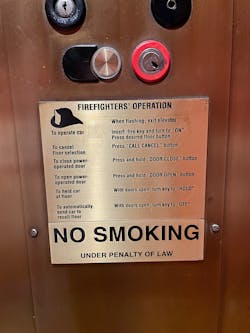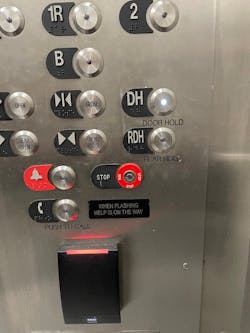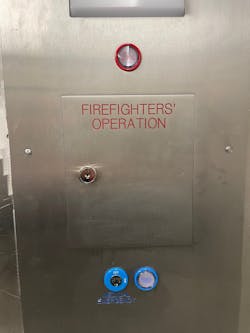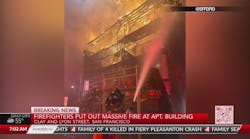Elevator use on the fireground has become increasingly necessary and more common as our built environment’s challenges continue to grow. Unfortunately, tragic mishaps took place that killed and injured firefighters, because the elevator doors were opened and remained open into untenable smoke and fire conditions.
Regulations
The ASME A17.1 Safety Code for Elevators and Escalators has provisions for firefighter safety during emergency operations and requirements for how the doors react under Phase II control. The requirements allow firefighters to have complete control of the doors. The provisions must be incorporated into the design, manufacture and installation of elevators to guard against the doors remaining open. One key feature is by way of constant pressure on the Door Open button. When fire or smoke conditions are found inadvertently, the simple release of the button allows the doors to close automatically. This function can be known as peek-a-boo: A firefighter can depress the Door Open button, and if the button is released, the doors close automatically.
The code is very clear that nothing shall interfere with the door operation during Phase II operation.
Concern
The issue of the door remaining open might appear when the in-car Stop switch is activated. For example, when an elevator car is landed at the desired floor and then the in-car Stop switch is activated and then the Door Open button is depressed, one of two conditions could happen that might interfere with the peek-a-boo safety feature: The doors won’t open or the doors will open but won’t close when the Door Open button is released.
It is important to note two key things. First, these conditions don’t happen when the Emergency Stop switch, which is located within the dedicated firefighter control panel, is activated inside of elevator cars that are equipped with that panel. Second, most of the in-car Stop switches are either keyed or behind a locked panel that requires a key to access. This should inherently make access to them more limited but not impossible. It could be possible for these switches to be a toggle type or a push/pull type in older elevator cars. If one of these types is the only Stop switch in an elevator car, the switch must work the same as the Emergency Stop switch that’s located in the dedicated firefighter control panel.
Effect
Nearly 7,000 out of an approximate 40,000, or roughly 15 percent, of Massachusetts elevators were identified to have either of those conditions that are described above. The good news is that fixes are in place, and the number of affected elevators reduces daily.
This condition was reported to exist in other states, too. It’s believed that the fixes already were completed or are in the process of being completed in those states.
Fix
Depending on the equipment, the correction can be something of a simpler sort, involving only a reprogramming of the computer software to the in-car Stop switch. However, a more complex sort of fix might be required, involving replacement of hardware, such as switches, control arms and wiring. Some fixes might need a combination of software and hardware.
Wrong direction
Another thing to be mindful of is to be sure that none of the fixes creates another issue. For example, it was found that a fix to the peek-a-boo function on some elevators caused the elevator car to stall once it left the landed zone and if the in-car Stop switch became activated during travel. This condition can cause firefighter entrapment and only can be reversed by a manual resetting/rebooting in the elevator machine room.
Door response failure
If you ever use an elevator under Phase II operations and suddenly find yourself in a situation in which the doors don’t respond the way that they should, try to locate and identify the position of the in-car Stop switch and turn it off. Hopefully, all should resume back to normal. Another solution could be to turn off the Phase II operation, at which point the elevator car should report back to the original location where you entered it. Be sure to report this to the proper inspectors in that jurisdiction for follow up corrective action.








